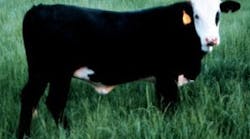CLA is made in the gut of ruminants from linoleic acid, and therefore is found mostly in beef, lamb and milk fat.
|
Though first described in 1935, interest the health potential of CLA was virtually nonexistent until 1979, when researchers Gayda and Pariza — looking at the potential carcinogenic effects of grilled meats — came upon a compound that appeared to have anti-tumor activity. Later, this compound was isolated and identified as a mixture of CLA isomers. Since then, many animal studies have shown that CLA may help to either prevent or halt the spread of a variety of cancers, including colon, prostate, ovarian and breast, as well as leukemia. What's even more encouraging is that this benefit occurs with relatively small quantities of CLA in the diet. And that's just the tip of the fatty iceberg. There's also hope that CLA may stop the progression of atherosclerotic plaque, alter body composition, benefit the immune system, and favorably impact diabetes and weight control.How might CLA act to prevent cancer?Cancer occurs in three general stages: initiation, where normal cells are transformed into endlessly dividing cancer cells, promotion, where cancer cells multiply and collect into tumors, and progression, or metastasis where the cancer invades other areas. Animal studies demonstrate the potential action of CLA at each of these stages.In 1987, Pizara isolated CLA. Adding it to the skin of mice initiated with a known carcinogen resulted in a 50% reduction in tumor formation. Decreased levels of the endogenous antioxidants catalase and superoxide dismutase suggested that CLA acted as an antioxidant, preventing the DNA damage that transformed normal cells. In a 1996 study by Belury, tested a similar mouse skin model using CLA in the diet. Increasing levels of CLA from 0-1.5% in the diet progressively reduced tumor formation. The mechanism of protection appeared to go beyond free radical scavenging to include reduction of the inflammatory processes. CLA may alter the production of the hormone-like prostaglandins, thromboxanes, and leucotriens. These compounds occur in different forms, depending upon the membrane fatty acids from which they are built. Some promote and others inhibit the inflammatory process.By introducing CLA in the diet, membrane fatty acids are altered, favoring the less inflammatory compounds. In addition, the enzymes that control the synthesis of the inflammatory compounds may be inhibited. Studies of mouse mammary tumors, and rat stomach tumors have confirmed the reduction in tumor formation with as little as 0.1% concentration of CLA in the diet. In rats with implanted tumors, CLA in the diet has been shown to reduce the spread of lung cancer. Results show that local tumors were smaller and lung tumor load was significantly reduced. There are interesting mechanisms propose by which CLA may halt metastasis. CLA is susceptible to oxidation, becoming a radical that damages cancer cells via lipid peroxidation. This cytotoxicity is apparently specific to cancer cells. CLA may also down regulate DNA necessary for cancer cell growth, and initiate cell death. Dr. David Kritchevski, noted researcher of the Wistar Institute at University of Pennsylvania, found that CLA may protect us against cancer by slowing angiogenesis, the process by which cancer cells build the vascular infrastructure necessary for their invasion of other tissues. CLA decreased the production of vascular endothelial growth factor.What other promise does CLA hold?Many potential benefits of CLA await further clarification, as results in humans are inconsistent. There is some epidemiological evidence has linked low levels of CLA with increased risk of breast cancer in post-menopausal women. The anti-inflammatory properties of CLA may help to prevent the build up of plaque in arteries, which begins as an inflammatory process. The antioxidant potential may improve blood lipid and cholesterol profiles, though some studies show reduction if HDL cholesterol. Some studies indicate that CLA may aid weight loss and alter body composition. For example, Swedish researchers reported in December, 2000 that CLA reduced fat while boosting muscle mass in obese participants taking 3.4 grams of CLA daily for 64 days (the average American ingests probably less than 1 gram of CLA per day). Others studies showed no such effect. Protection from insulin resistance also has mixed results, with some studies showing increased insulin resistance with supplemental CLA.Part of the problem is that many of the effects of CLA appear to depend on the form or isomer under study. Naturally occurring CLA is a mixture of different isomers. Results with supplemental CLA may depend on which forms, and what proportions of isomers are used, along with other fats in the diet. There is much promise in CLA research, but it's still unclear how much of the promise demonstrated in animal studies will transfer to humans. How do we get the benefits of CLA now?Until potential health benefits are further clarified, we can take advantage of CLA very simply. Many studies have made it clear that increasing the quantity of grass in the diet of cattle decreases the saturated fatty acid concentration while increasing the omega-3 fatty acid and conjugated linoleic acid concentrations. So, the most natural way to obtain a healthy amount of CLA is through the use of beef, lamb and dairy products from grass-fed animals. In other words, we should eat meat and dairy more like our great-grandparents did.

